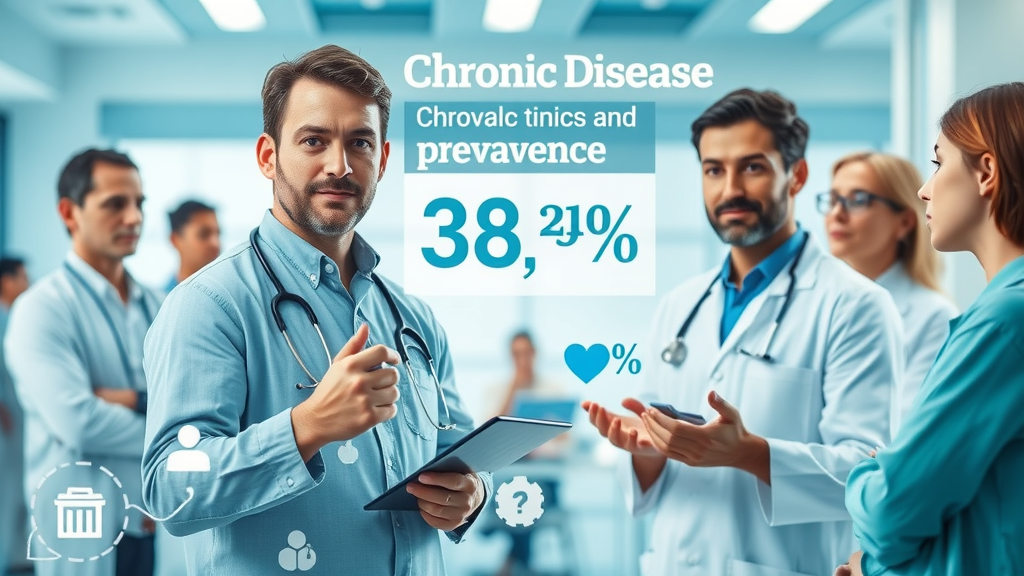Imagine a world where physicians can closely monitor patients beyond the clinic walls, respond proactively to needs, and improve health outcomes—all with the click of a button. As the healthcare landscape evolves, Remote Therapeutic Monitoring for physicians is rapidly emerging as the gold standard of care. This transformative approach leverages cutting-edge digital tools to streamline patient management, personalize interventions, and strengthen the physician-patient connection. Read on to discover how embracing digital innovation can simplify your daily practice, empower your patients, and boost your clinical impact.
Why Remote Therapeutic Monitoring for Physicians is Revolutionizing Healthcare Delivery
Remote Therapeutic Monitoring for physicians (RTM) is radically changing how healthcare is delivered by enabling clinicians to track patient progress and therapeutic adherence in real time, long after the patient leaves the office. Unlike traditional episodic care, RTM encompasses ongoing remote assessment of patient symptoms, medication use, and adherence to treatment plans via digital devices and apps. This continuous flow of actionable data allows physicians to detect issues early, tailor interventions, and proactively support patient recovery.
The adoption of RTM is not just a trend—it addresses critical gaps in conventional healthcare, particularly for chronic conditions where daily management is crucial. For instance, a physician managing a patient with asthma can remotely track inhaler usage and respiratory symptoms, quickly intervening if patterns suggest worsening control. With RTM, physicians get a true, data-driven window into their patients’ everyday health, while patients benefit from seamless, personalized care guidance. It's this real-time connection that empowers both physicians and patients, making healthcare more dynamic, responsive, and ultimately, more effective.

Understanding the Fundamentals of Remote Therapeutic Monitoring for Physicians
At its core, Remote Therapeutic Monitoring for physicians involves the use of digital health tools—such as wearable medical devices, smartphone apps, and connected medication dispensers—to collect and transmit patient data from home to the clinic. Key elements tracked include adherence to medication, pain levels, physical therapy progress, and other disease-specific signs. Unlike remote patient monitoring, which centers on physiological data like heart rate or blood pressure, RTM focuses on how well patients are following prescribed therapeutic regimens and the outcomes of those interventions.
For physicians, integrating RTM starts with selecting appropriate, user-friendly technologies that align with their patient population and clinical workflow. Training patients to use these devices and ensuring secure, two-way data exchange are vital steps. Once implemented, RTM platforms aggregate individual patient data into intuitive dashboards, alerting clinicians to nonadherence or deteriorating trends and supporting timely, evidence-based clinical decisions.
By understanding these fundamentals, physicians can harness RTM not only to enable better outcomes but also to promote patient engagement, ensure medication compliance, and close the feedback loop between office visits. The result is a system where care is truly continuous and responsive.
Benefits and Impact of Remote Therapeutic Monitoring for Physicians on Patient Outcomes
The benefits of Remote Therapeutic Monitoring for physicians are profound and multifaceted. Most notably, RTM enhances patient outcomes by providing physicians with a richer, more detailed picture of each individual’s journey, far beyond what’s discussed during routine check-ins. The ability to track therapeutic activities, such as physical therapy exercises or medication adherence, empowers physicians to intervene quickly if a patient deviates from their care plan, preventing complications and reducing hospitalizations.
RTM also fosters a higher level of patient engagement. When patients know their progress is being monitored in real time, they often feel more accountable and supported, leading to higher treatment adherence and satisfaction. For example, studies show that regular feedback and reminders delivered via digital health tools can boost daily adherence rates and reduce missed therapy days.
The measurable impact extends to economic efficiency as well, by lowering emergency visits, optimizing resource allocation, and supporting value-based care initiatives. Physicians leverage RTM to demonstrate improved outcomes, supporting healthcare models that reward proactive, high-quality care.

How Remote Therapeutic Monitoring for Physicians Enhances Clinical Workflow
Remote Therapeutic Monitoring for physicians is not only about patient outcomes; it is a powerful tool for optimizing clinical workflows and reducing administrative burdens. Through automation, digital alerts, and real-time dashboards, RTM enables care teams to quickly triage patients, follow up with those needing immediate attention, and personalize follow-up recommendations. This shift decreases the time spent reviewing paper records or making unproductive calls, allowing physicians to allocate more time to direct care and complex cases.
Clinical workflow enhancements extend across the care team. Medical assistants, nurses, and therapists can coordinate seamlessly, updating the patient’s RTM data in the EHR and ensuring everyone has the latest information for effective care planning. These efficiencies translate directly to improved practice throughput and a higher standard of care.
In addition, integrated messaging features within RTM platforms make communication between patients and providers smoother. Physicians can share progress updates, answer questions, or give quick guidance without lengthy phone calls—streamlining the clinical cycle and improving patient satisfaction.
Integrating Remote Therapeutic Monitoring with Existing EHR Systems
A key feature of effective Remote Therapeutic Monitoring for physicians is seamless integration with Electronic Health Records (EHRs). RTM platforms designed with interoperability in mind connect directly to EHR systems, automatically syncing patient data and generating actionable insights without requiring double entry or juggling multiple platforms. This integration is essential for reducing clerical work and preventing data silos, ensuring continuity and accuracy in patient records.
When EHR integration is smooth, providers can access consolidated reports, trend analyses, and custom alerts within the patient chart. This means that during visits—virtual or in-person—clinicians have a holistic view of the patient’s therapeutic progress, leading to more informed care decisions and coordination among care team members. Successful integration also speeds up billing, quality reporting, and compliance monitoring by collating all relevant RTM documentation in one place.
Selecting RTM solutions that are certified for interoperability with leading EHRs (like Epic, Cerner, or Allscripts) is a critical step for practices looking to reduce workflow friction and boost clinical efficiency.
Streamlining Communication with Patients Using Remote Therapeutic Monitoring
Remote Therapeutic Monitoring for physicians improves patient-provider communication by creating structured, secure, and timely interactions outside traditional appointments. Many RTM tools feature built-in patient portals, chat functions, and push notifications, supporting regular check-ins and rapid response to questions or emerging symptoms. This keeps patients engaged and reassured, reinforcing adherence and trust in their physician’s care.
The ability to automate reminders or send personalized feedback—such as congratulations for hitting milestones—can significantly motivate patients to stay on track. Physicians can also use RTM messaging to clarify instructions, adjust therapy parameters, or escalate care, all documented in real time. These capabilities foster a more collaborative relationship, making patients active participants in their health journey.
For clinical teams, these streamlined communication channels minimize missed messages and reduce the phone-tag that often delays care. This digital-first approach to interaction enables efficient triage, timely interventions, and positive patient experiences.

Maximizing Practice Efficiency: Remote Therapeutic Monitoring for Physicians in Daily Operations
In daily clinical practice, Remote Therapeutic Monitoring for physicians transforms productivity by automating routine follow-ups, centralizing data collection, and enabling targeted patient engagement. The automation inherent in RTM means less time spent on administrative tasks and more on meaningful clinical interactions. For instance, scheduled RTM alerts remind care teams to review patient adherence, flagging those who require outreach or medication adjustments before minor issues escalate.
Because many RTM activities can be delegated or automated—such as data review or sending reminders—even smaller practices without dedicated IT staff can benefit. Over time, physicians find that these efficiencies lead to higher patient volumes, fewer preventable complications, and robust compliance with quality reporting standards.
The ability to document RTM services efficiently also unlocks new reimbursement streams, creating a sustainable business model that aligns incentives for patient-centered, technology-driven care.
Examples of Remote Therapeutic Monitoring Tools for Physicians
Today’s market offers a variety of Remote Therapeutic Monitoring for physicians solutions, designed to meet unique clinical needs and patient populations:
- Wearable devices: Smart bands and patches track medication usage, physical therapy compliance, and even pain levels in real time.
- Smart medication dispensers: Connected pillboxes register medication adherence, sending alerts for missed doses and compliance reports to the care team.
- Mobile apps: Purpose-built applications guide patients through prescribed exercises, track symptoms, administer surveys, and allow secure communication with their physician.
- Digital dashboards: Comprehensive web portals aggregate patient data, calculate trends, and highlight urgent needs, streamlining clinical oversight.
When choosing a tool, physicians should prioritize ease of use, data security, and interoperability with their existing health IT systems. This ensures rapid adoption and ongoing user engagement across all stakeholders—patients, care teams, and administrators alike.
Best Practices for Successful Remote Therapeutic Monitoring Implementation
Implementing Remote Therapeutic Monitoring for physicians is most successful when practices follow a set of best practices. First, secure staff and patient buy-in early through clear education around RTM’s benefits and expected workflows. Start with a pilot group of patients to test the process, collect feedback, and address early challenges without overwhelming the clinical team.
Next, develop standard operating procedures for RTM activities: Who will review incoming data? How will abnormal findings be triaged? What communication channels will be used for different types of alerts? Assigning clear roles helps ensure no data is lost and all patients receive consistent care.
Finally, continuously evaluate performance using metrics like adherence rates, number of clinical interventions, and patient satisfaction scores. Adjust protocols as needed based on feedback and new developments in technology or regulations.
"Remote Therapeutic Monitoring for physicians empowers continuous, data-driven care management that bridges the gap between clinic and home."

Key Considerations and Compliance for Remote Therapeutic Monitoring for Physicians
To fully realize the potential of Remote Therapeutic Monitoring for physicians , it’s essential to navigate regulatory requirements, patient consent, and secure data handling with precision. Physicians should ensure their RTM platforms comply with all relevant laws while providing a seamless user experience.
Understanding payer policies and documentation requirements helps maximize reimbursement and avoid costly errors. With careful planning, RTM can be integrated into your practice with minimal disruption and optimal impact.
Understanding HIPAA, Reimbursement, and Data Security in Remote Therapeutic Monitoring
HIPAA compliance must be top of mind when adopting RTM. Ensure that all transmitted and stored patient data—especially personally identifiable information—is encrypted, access-controlled, and auditable. Select vendors with robust security credentials and third-party certifications.
Reimbursement for RTM services is evolving rapidly, with Medicare and many private insurers recognizing the value of continuous therapeutic oversight. Physicians must accurately document the services provided, the clinical rationale, and patient consent for remote data collection to qualify for payment. Familiarity with CPT codes (such as 98975–98977) streamlines the billing process and ensures you capture all eligible revenue.
Finally, written privacy policies and workflows for responding to data breaches or security incidents protect both the practice and patient trust. Ongoing staff training and regular security audits help maintain compliance as regulations or technologies change.
Navigating Billing Codes for Remote Therapeutic Monitoring for Physicians
Proper use of RTM billing codes is critical for ensuring fair compensation without compliance headaches. The most common codes include CPT 98975 for device setup, 98976–98977 for supply of devices measuring respiratory or musculoskeletal systems, and 98980–98981 for treatment management services, reflecting both initial and ongoing care.
Each code requires accurate records documenting patient enrollment, setup, data received, time spent analyzing patient data, and communications or clinical decisions made because of that data. Work closely with your billers or financial team to match your RTM activities to appropriate codes and payer requirements.
Regularly update protocols to reflect changes in insurer guidance and leverage billing partners with RTM expertise to keep your claims process smooth and error-free.
| Platform | Key Features | Cost | EHR Integration | Support & Training |
|---|---|---|---|---|
| CareInnovateRTM | Wearable integration, automated alerts, real-time dashboards | $$ | Epic, Cerner, Allscripts | 24/7 live chat, on-demand webinars |
| TeleTherapy360 | App-based surveys, secure messaging, data analytics | $ | Most EHRs, HL7/FHIR compatible | Email & phone support, user manuals |
| MonitorX Suite | Medication tracking, compliance alerts, custom reports | $$$ | Epic, AthenaHealth | Dedicated account manager, staff onboarding |

Common Challenges and Solutions in Remote Therapeutic Monitoring for Physicians
While Remote Therapeutic Monitoring for physicians offers significant rewards, implementation can be hampered by challenges such as patient engagement, technology complexity, and the need for ongoing staff training. Successful programs are proactive about identifying and addressing these potential pitfalls.
Patient barriers can include lack of digital literacy, distrust of new technologies, or hesitation about data privacy. Technical challenges may arise when integrating disparate platforms or when existing infrastructure is outdated. Each of these challenges can be addressed with thoughtful protocols, patient education, and consistent technical support.
The key is to anticipate hurdles, assign clear responsibility within the care team, and maintain open lines of communication with both patients and solution vendors.
- Patient adherence: Offer onboarding education, regular reminders, and celebrate milestones to motivate consistent RTM engagement.
- Data accuracy: Select validated devices and cross-check self-reported metrics with objective measures whenever possible.
- Technology integration: Choose RTM tools that natively connect with your EHR, reducing manual entry and data loss.
- Training staff: Provide comprehensive onboarding and ongoing learning opportunities for your team at all levels.
- Addressing technical support issues: Partner with vendors offering timely, responsive support, and designate super-users in your practice to triage simple questions.

Video: Step-by-Step Guide to Implementing Remote Therapeutic Monitoring for Physicians
For a visual introduction, watch our comprehensive video guide that demonstrates the key steps involved in rolling out Remote Therapeutic Monitoring for physicians . You’ll see practical demonstrations of device setup, patient onboarding, and real-time communication—all designed to expedite your practice’s RTM journey.
[Note: Embed or link to the demonstration video relevant to RTM implementation for physicians here]
People Also Ask: Remote Therapeutic Monitoring for Physicians
What is the difference between Remote Therapeutic Monitoring and Remote Patient Monitoring for physicians?
Remote Therapeutic Monitoring (RTM) focuses on tracking a patient’s adherence and response to prescribed therapeutic activities like medication use and physical therapy exercises, often via digital devices and self-reported data. In contrast, Remote Patient Monitoring (RPM) centers on the collection of physiological metrics—such as blood pressure, heart rate, or glucose levels—using connected medical devices. While both improve care outside the clinic, RTM is specifically designed for overseeing how well patients follow and benefit from therapeutic treatment plans.
How does Remote Therapeutic Monitoring improve patient engagement for physicians?
RTM motivates patients by providing real-time guidance, personalized reminders, and direct feedback through digital tools. Knowing their activities and progress are being monitored helps patients feel supported, accountable, and involved in their care. Physicians, in turn, can intervene quickly when challenges arise, fostering a partnership that leads to higher rates of adherence and improved outcomes.
What are the reimbursement opportunities for physicians using Remote Therapeutic Monitoring?
Healthcare payers increasingly recognize the value of RTM and now reimburse a range of related services under dedicated CPT codes. Physicians can bill for device setup, monthly data review, and time spent managing patient therapy remotely. Accurate documentation, patient consent, and clear demonstration of clinical decision-making based on RTM data are essential for maximizing reimbursement.
How can physicians ensure compliance and data security with Remote Therapeutic Monitoring?
Compliance relies on selecting RTM solutions that are fully HIPAA-compliant, encrypting all patient data at rest and in transit, and regularly training staff on best data protection practices. Establish clear privacy policies, conduct periodic security audits, and prepare action plans for potential data breaches to build trust with patients and regulators.
Frequently Asked Questions about Remote Therapeutic Monitoring for Physicians
- What devices can be used for remote therapeutic monitoring in a clinical setting? Clinicians can utilize FDA-approved wearable sensors, connected pill dispensers, mobile RTM apps, and digital therapy trackers, depending on the condition and desired metrics.
- Are there ready-made templates and protocols for physicians starting with RTM? Yes, many RTM vendors provide customizable templates, onboarding documents, and workflow guides to speed adoption and ensure regulatory compliance.
- How frequently should physicians review RTM data with patients? At minimum, data should be reviewed monthly for compliance; high-risk cases may require weekly oversight or teachable touchpoints when nonadherence is detected.
- Is physician training required for new RTM systems? While most RTM platforms are user-friendly, initial physician and staff training is highly recommended to maximize clinical value and ensure smooth integration into daily practice.
Essential Takeaways on Remote Therapeutic Monitoring for Physicians
Remote Therapeutic Monitoring delivers proactive, data-driven care, simplifies workflows, boosts patient outcomes, and drives new revenue streams. Success requires selecting secure, user-friendly tools, integrating with EHRs, prioritizing patient and staff education, and staying compliant.
Build the Future of Your Practice with Remote Therapeutic Monitoring for Physicians Today
Embrace Remote Therapeutic Monitoring for physicians and advance your practice to the next level of personalized, connected, and efficient patient care. The future of healthcare is digital—lead the way now!
 Add Row
Add Row  Add
Add 



Write A Comment